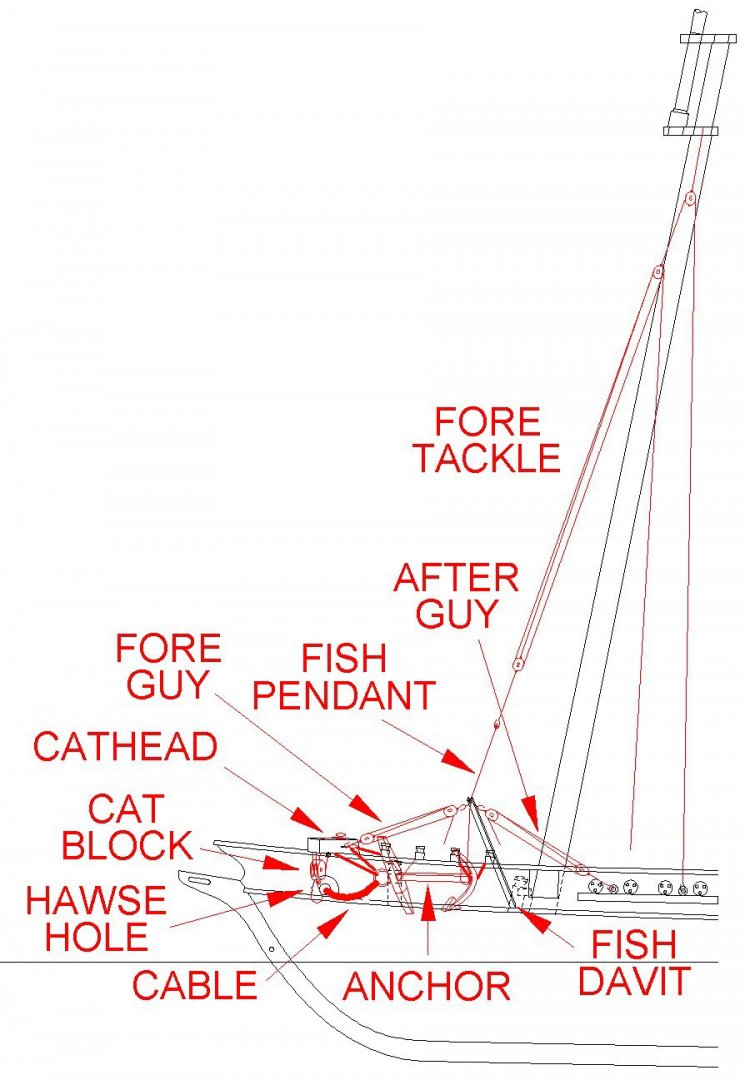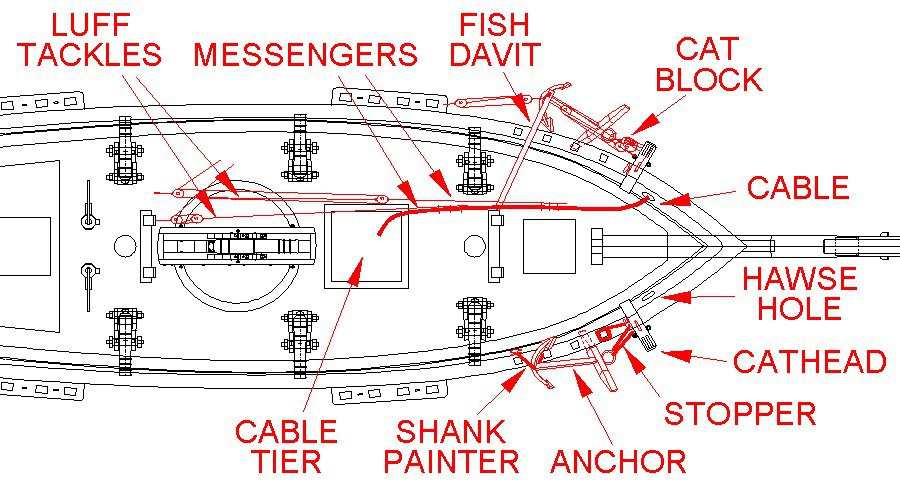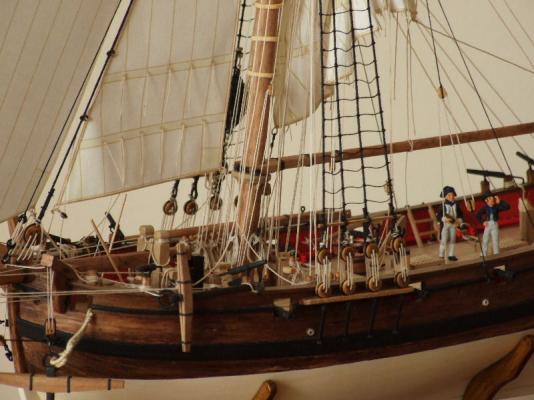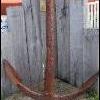Search the Community
Showing results for tags 'anchor'.
-
I have been working on a model of a topsail schooner, and had a number of questions about how the anchors were handled. Looking through the literature, and at some of the schooner models on the Forum, it seems that there are several different methods. So which was right for the model I am building? I have a 1980s Mantua Albatros "Goletta Typpica de Baltimora" kit. The kit contains a lot of the "standard" parts the company threw into many kits, regardless of scale and many of these were not well made. When I compare the kit to drawings in Chapelle's The Baltimore Clipper I see a lot of questionable details. The kit includes a capstan, and some topsail schooners used capstans for weighing anchor. But many kits and drawings have windlasses, and some show nothing for handling the anchor. There are other discussions on the Forum about anchor handling in small craft, with lots of opinions. What I present here is a compilation of these discussions and material from several references. What I am interested in is how smaller ships that had no windlass or capstan handled the anchor. Anchor Tackle The anchor tackle on smaller vessels consists of two assemblies used for dropping and raising the anchor. Larger ships may have permanent fish davits and a different arrangement for handling the anchor. Small ships often used a version of what is shown here. The crown or fluke end of the anchor is typically secured to the side of the ship with a shank painter of rope or chain secured to bitts or timberheads to support the fluke end. A stopper rope to support the stock of the anchor is secured to the cathead on one end, looped through the anchor ring and then the free end is looped around a cleat and secured to a timberhead. To drop the anchor the anchor cable is brought up from the cable tier, run through the hawse hole and secured to the ring on the anchor (on some ships the cable is always attached to the anchor ring). Then the cat block and hook are attached to the anchor ring. The fish davit is rigged with it resting on the cap rail and the inboard end resting against some firm object like the mast or knight head. The davit may be positioned over the anchor flukes using fore and after guys. The fish pendant runs over a sheave in the end of the fish davit. It has a large fish hook on the lower end and the upper end is tied around a thimble. The fore tackle is hooked into the thimble and provides the lifting force to raise and lower the anchor. I have also seen drawings where the fish tackle was rigged to the fore course spar and a fish davit was not used. With the fish pendant and cat tackle pulled tight the shank painter securing the anchor to the ship is removed. The anchor is then lowered along the ship's side with the fore tackle and fish pendant until it is hanging beneath the cathead on the cat tackle. Then the fish hook is unhooked and taken in. The cat tackle is slacked to allow the stopper to carry the weight of the anchor, and then the tackle is tied back to clear the anchor. To drop the anchor the stopper is released from the timberhead and allowed to slip over the cleat, allowing the anchor to fall. To weigh (raise) the anchor the anchor cable is hauled in using tackles (smaller vessels), a windless or a capstan and messenger line (larger ships). Smaller schooners often did not have a capstan or windlass so one or two luff tackles were used to pull a messenger line that was lashed to the anchor cable. If one tackle was used when it became two blocked (both blocks come together) the anchor cable was secured to the bitts and the messenger was run out again and tied to the cable. When two tackles were used and one tackle was two blocked the other tackle was tied to the cable to continue pulling while the first was run out again. The messenger line might be a loop with one side tied to the anchor cable to haul it in and the other returning forward. When the anchor broke the surface the cat hook was attached to the anchor ring. Then the anchor was “catted” by raising it to the cathead with the cat tackle. The fish davit and pendant were rigged and the fish hook was hooked to the anchor stock at the flukes. The anchor was “fished” using the fore tackle to hoist the flukes up to the cap rail where the shank painter ropes or chains were passed around the anchor and secured to timber heads or cleats to support the anchor. Then the fish pendant was unhooked. A wooden fender or "shoe" was placed between the anchor flukes and the side of the ship to protect the hull as the anchor was being fished. On some ships the anchor head remained suspended by the cat tackle. On other vessels the head of the anchor was secured with stopper lines to cleats or timberheads. The cat tackle was usually left hooked to the anchor ring. The anchor cable may have been removed and stowed in the cable tier. One reference said two hefty seamen could hoist a relatively light anchor with a simple tackle. By increasing the number of sheaves in the tackle greater lifting power could be achieved, but at the expense of having to pull more line through the tackle and a much slower process. But with heavier anchors this system was not practical. Instead of the luff tackles a capstan could be used to pull a messenger loop wound around the capstan and running around the fore deck and back to the capstan. The messenger was tied to the anchor cable and hauled back until the lashings reached the cable tier. Then new lashings would be tied around the cable and messenger up forward and the hauling would be continued until the anchor was catted. With a windlass on the fo'c'sle the anchor cable would be wound around the barrel or warping drum. For dropping the anchor the winch would be allowed to rotate freely. When weighing the anchor the windlass ratchet mechanism would allow men with poles to turn the barrel to haul in the cable. The cable could be secured with stopper lines to bitts. One other detail I came across is that the anchor might be hauled inboard after the cable was detached and stored below decks in the cable tier. Here are a couple of useful references: The Young Sea Officer's Sheet Anchor by Darcy Lever in 1808 (reprinted by Algrove Publishing Ltd., Ottowa, Ontario, Canada, 2000) tells the novice officer or seaman how to rig a ship - every detail of how to put all the pieces of the masts and rigging together. It is essentially an illustrated glossary of nautical terms and a how-to book. It has a discussion of anchors and anchor handling. The Art of Rigging by George Biddlecombe in 1925 (reprinted by Echo Point Books & Media, LLC., Brattleboro, Vermont, USA, 2016) is based upon David Steel's 1794 The Elements and Practice of Rigging and Seamanship. It has an excellent glossary and many illustrations. I think you can find Steel's original book on line as a PDF file.
- 24 replies
-
- anchor handling
- schooner
-
(and 1 more)
Tagged with:
-
Super detailing the cutter Sherbourne, a guide to building the Caldercraft kit, by George Bandurek. I published this book in 2011 and at the time there were several threads that showed photos of my build. These are not now easily accessible so I have resurrected some of the information. The attached pdf files are extracts from the book that show how I tackled some of the topics. I would welcome any comments on these extracts, or if you have bought a copy of the book (thank you!) then please post a review. More information on the book is available on my website www.grbsolutions.co.uk. Buy direct and you will get a signed copy! George Bandurek Shrouds.pdf Sails MB.pdf Cannon.pdf Anchors.pdf
- 10 replies
-
- Sherbourne
- Jotika
-
(and 5 more)
Tagged with:
-
Hi all, I'm researching the anchors for my Oneida (1809) model, and it seems to be a transitional period for anchors. Looking at contemporary models, most from this period show angle-arm anchors, but a couple are round-arm. The Hornet (1805) sailor's model, also an American ship, is one of the round-arm ones. Also, around this time the stock seems to have transitioned from wood to iron. In Chapelle's book, in the appendix listing spar dimensions for Argus (1803), it lists the anchors to be with iron stocks. It's probably my choice on both the angled or round arms, and wood or iron stock, but before I decide I wanted to get some opinions or info from anyone who knows more about it. Thanks, Ron
-
Can anyone help with pictures or info on how the anchor was rigged? I would like to have anchor lines on the gun deck from the capstan forward to the anchor to as though the anchor was being lowered or raised. Were the anchors rigged so both were raised/lowered at the same time? Thanks
-
good afternoon Please help in finding information about the number, weight of anchors, which allowed for each ship in the Royal Navy in the late 18th century. Maybe there's method of calculating the weight of the anchor according to the tonnage of the ship? I'm interested in the weight of the anchor for the 22gun brig-сutter 342 tons in 1788 Plan showing the measurements for anchors as well as descriptions, diagrams, and dimensions fo rh anchors up to 80 hundredweight in divisions of one cwt. From Tyne & Wear Archives Service, Blandford House Dated: 1794 thank you
About us
Modelshipworld - Advancing Ship Modeling through Research
SSL Secured
Your security is important for us so this Website is SSL-Secured
NRG Mailing Address
Nautical Research Guild
237 South Lincoln Street
Westmont IL, 60559-1917
Model Ship World ® and the MSW logo are Registered Trademarks, and belong to the Nautical Research Guild (United States Patent and Trademark Office: No. 6,929,264 & No. 6,929,274, registered Dec. 20, 2022)
Helpful Links
About the NRG
If you enjoy building ship models that are historically accurate as well as beautiful, then The Nautical Research Guild (NRG) is just right for you.
The Guild is a non-profit educational organization whose mission is to “Advance Ship Modeling Through Research”. We provide support to our members in their efforts to raise the quality of their model ships.
The Nautical Research Guild has published our world-renowned quarterly magazine, The Nautical Research Journal, since 1955. The pages of the Journal are full of articles by accomplished ship modelers who show you how they create those exquisite details on their models, and by maritime historians who show you the correct details to build. The Journal is available in both print and digital editions. Go to the NRG web site (www.thenrg.org) to download a complimentary digital copy of the Journal. The NRG also publishes plan sets, books and compilations of back issues of the Journal and the former Ships in Scale and Model Ship Builder magazines.








